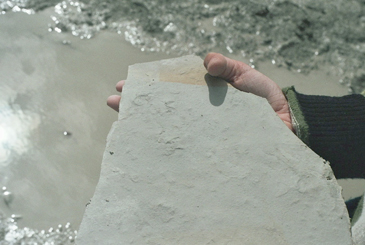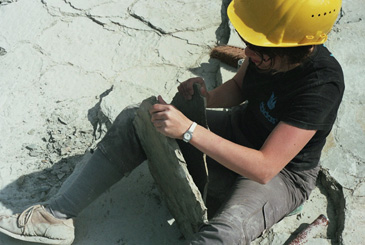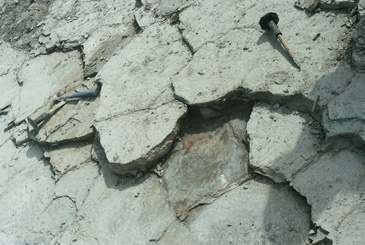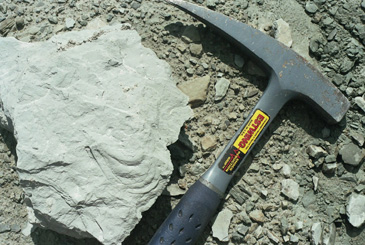
|

| Home | Milieu & Energie | Gezondheid & Wetenschap | Duurzaam Bouwen | Photo Gallery |
| Geologie & Reizen | Landbouw & Voeding | Natuurbescherming | Eilanden | Geo-educatie |
|
|
Consolidated rock is scarce in the Netherlands. Our country is a delta filled with
loose sediments of sand and clay. Only in the parts near Belgium and Germany, hard rock
appears at the surface. We are lucky that quarries in these border areas show
us the treasures of our subsurface here. These treasures contain trace and body fossils of
prehistoric reptiles. |
|
Near the Dutch village of Winterswijk, Mesozoic limestone is quarried for use in road building and as a
lime fertilizer.
But this Triassic limestone, dating from the Muschelkalk Period, doesn't serve economic purposes only.
The quarry is a unique site, as many fossils of Triassic marine and land life, but also minerals can be found here. In this quarry, mainly amateur geologists and palaeontologists, but also scientists, look for trace and body fossils of reptiles that lived in this area around 240 million years ago. Some of the traces of these ancient reptiles, which became extinct in the Jurassic, were well kept in the lime mud along the former coastline of a shallow sea, which must have been similar to the Dutch Waddensea in present times. Both land and marine reptiles inhabited the coastal areas of the Muschelkalksea. |

|

|
'This quarry is one of the best sites for finding Middle Triassic
fossils,' Paul Albers says. During summer holidays, Paul, who works as a guest researcher for the
Dutch National Museum of Natural History Naturalis, supervises groups of students during their
fieldwork. The search for fossils in the quarry takes place by students
but also by the general public during weekends and summerholidays, when
the company exploiting the quarry, Ankerpoort -which permits the fieldwork- has a summer stop. Imprints of the claws of the Rhynchosauroides peabodyi are very common in the Winterswijk quarry. Even the imprint of it's skin is clearly visible on some limestone pieces that are well kept in the local museum Freriks. This reptile lived on land and unfortunately, no bone fossils of this saurid have been found yet in Winterswijk. |
|
However, trace fossils can be an important source
of information for palaeontologists. Traces can tell a lot about the weight of the reptile and its walking speed.
Last year, members of the Dutch Geological Society (NGV) found a trace sequence measuring more than ten metres.
That's what makes this area unique in the world! 'We
need at least three imprints in line for learning more about their behavior,' Paul adds. To increase the chance of finding trace fossils, or 'ichnofossils', the laminated limestone is split with great care into even thinner plates of about half a centimetre, or even thinner. The limestone 'tiles' are taken out of the subsoil with great care, using common tools such as crowbars. |

|

|
Apart from trace fossils, body fossils are found in Winterswijk as well, such as
fish scales and fish bones varying in size from only a few centimetres to about one metre, and
bones from reptiles.
The tropical, shallow Muscheskalksea was home to many saurid species, such as the
Nothosaurus, a marine reptile of the sauropterygian order, hunting for fish.
Bone fossils of two species of Nothosaurs (N. winterswijkensis,
and N. marchicus) and Anarosaurus heterodontus were discovered in the quarry in Winterswijk. More recent species of Nothosaurus are found in the Upper Muschelkalk in Southern Germany. These marine reptiles thrived the shallow Triassic seas and are considered to be the ancestors of the Jurassic plesiosaurs. |
|
Other trace fossils in this
quarry originate from crustacea, like Rhizocorallium (photo right). Limestone with imprints of shells are very common.
Although the name 'Muschelkalk' suggests that the limestone consists of shells, this is not the case. Usually the shells
are solved, and only the imprints are visible (see photograph below). Apart from fossils, minerals can be found in the quarry as well, such as calcite (CaCO3), pyrite (FeS2), marcasite (FeS2), coelestine/celestite (SrSO4) and galena (PbS). |

|

|
Middle Triassic Muschelkalk limestone from Winterswijk is too soft to use as a building material.
However, other limestone from the Muschelkalk
Period ('schelpkalksteen') is used in buildings as a construction material for outside or (decorative) inside
purposes. This limestone, consisting of cemented calcite shells, is for example used
in monuments in Amsterdam and originates from quarries in Germany. During summer months, the Dutch Geological Society organises guided excursions in the Winterswijk quarry. Reservations can be made at the local tourist office (see link below). |
|
Laatste wijziging: 16 oktober 2013
[home] [top] [contact] [disclaimer]